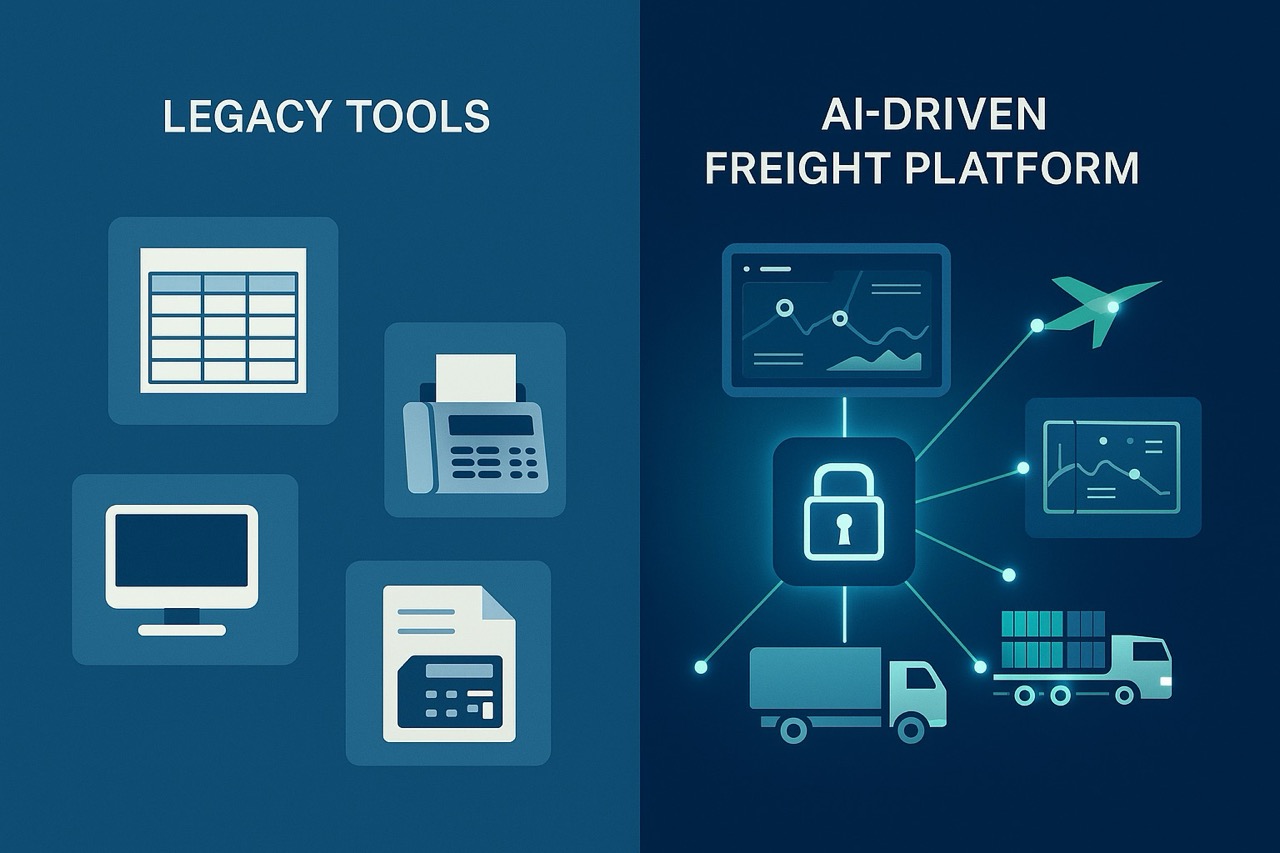Why Legacy Tools Fail Modern Freight
Introduction
5 tabs, 3 logins, 1 headache: the saga of why legacy tools are failing modern freight logistics. In the bustling world of logistics, phrases like these tell a vivid story of the daily struggles that logistics managers endure. Once viewed as state-of-the-art, legacy systems now block the path to improving efficiency and effectiveness. They create what we call data silos, which poison communication, hinder teamwork, and ultimately chip away at profitability. In fact, studies suggest that these data silos drain about 9.2% of annual revenue from the logistics sector. As businesses aim for success in a world interconnected by technology, incorporating contemporary solutions like CargoBridge’s Transportation Management System (TMS) along with its Marketplace is crucial. This article will discuss the fallout from relying on outdated systems in freight and how adopting a unified digital approach can lead to a more efficient logistics operation.
Chapter 1: The Cost of Data Silos in Logistics
The impact of data silos in logistics are enormous. When data gets trapped in different systems, achieving a holistic view of operations becomes almost impossible, leading to significant losses. Industry analyses reveal that these data silos may be responsible for a staggering 9.2% revenue loss annually, a figure that should alarm everyone in logistics.
“Data management and integrated systems are no longer optional in modern logistics, they are essential for the prosperity of businesses.”
The costs don’t stop at lost revenue. These silos delay decision-making, create redundant efforts, and severely limit a company’s ability to adapt quickly to market changes. Every minute wasted switching between systems could be better spent strategizing and optimizing logistics operations.
Chapter 2: Challenges with Legacy Systems
Legacy systems come with a host of challenges that contribute to inefficiencies in logistics operations. Here are some of the key issues:
- Multiple logins and systems: Many logistics managers find themselves juggling different platforms, each needing its own login. This juggling act wastes time and increases the risk of errors.
- Inconsistent data across platforms: Storing information in isolated systems leads to inconsistencies, which can cause confusion and result in poorly informed decisions.
- Time wasted switching between tools: Constantly toggling between various tools eats up valuable time, making it difficult for teams to concentrate on crucial operational tasks.
These issues create a chaotic environment where precious time is lost and opportunities slip through the cracks.
Chapter 3: The Rise of Digital Transformation
As the logistics industry faces mounting pressures for efficiency, there has never been a clearer need for digital transformation. Adopting new solutions is vital not just for meeting standards like eFTI (electronic Freight Transport Information) but also for achieving operational excellence. Digital transformation isn’t just about new technology, it’s about fundamentally rethinking how logistics companies work. From automating repetitive tasks to ensuring consistent data across systems, the shift to integrated digital solutions fosters connections and boosts productivity.
Chapter 4: Introducing CargoBridge’s Integrated Solutions
Meet CargoBridge: a groundbreaking platform that merges a powerful TMS with a comprehensive marketplace. CargoBridge addresses the challenges posed by legacy systems head-on. By seamlessly weaving together transportation operations and marketplace needs, it dismantles the barriers created by data silos, fostering a culture of connectivity and efficiency. Features of CargoBridge include:
- Real-time data sharing to ensure all stakeholders are aligned.
- Automated carrier matching to streamline the shipping process.
- A digital document vault to ensure compliance with eFTI requirements, thus mitigating the risk of errors and legal issues.

Chapter 5: Benefits of Workflow Automation
The advantages of using a workflow automation system are undeniable. With CargoBridge, organizations can harness powerful features that enhance efficiency, including:
- Automated notifications that keep teams informed and accountable.
- Streamlined processes that minimize manual entry and reduce errors.
- Dedicated templates for successful implementation, providing a solid foundation for your team to build on.
For those who sign up early, CargoBridge offers exclusive access to templates designed to optimize workflow processes, ensuring companies maximize their investment.
Chapter 6: Testimonials and Success Stories
Don’t just take our word for it, companies that have integrated CargoBridge have experienced remarkable results. One client reported a 30% increase in operational efficiency within the first three months of transition. New technology adoption allowed them to not only survive but thrive in a competitive market. Another logistics firm noted a reduction in administrative overhead, freeing up resources to focus on growth and customer service.
Conclusion and Key Takeaways
In a rapidly changing logistics landscape, clinging to legacy tools is a surefire way to invite stagnation and dissatisfaction. The consequences of data silos and outdated systems extend far beyond mere inconvenience; they threaten the survival of businesses. However, by embracing modern solutions like CargoBridge’s integrated TMS and marketplace, organizations can promote collaboration, improve revenue, and achieve operational excellence. The time to take charge of your logistics future is now. Sign up with CargoBridge today and unlock exclusive workflow automation templates crafted to streamline your processes and boost your business’s efficiency!






